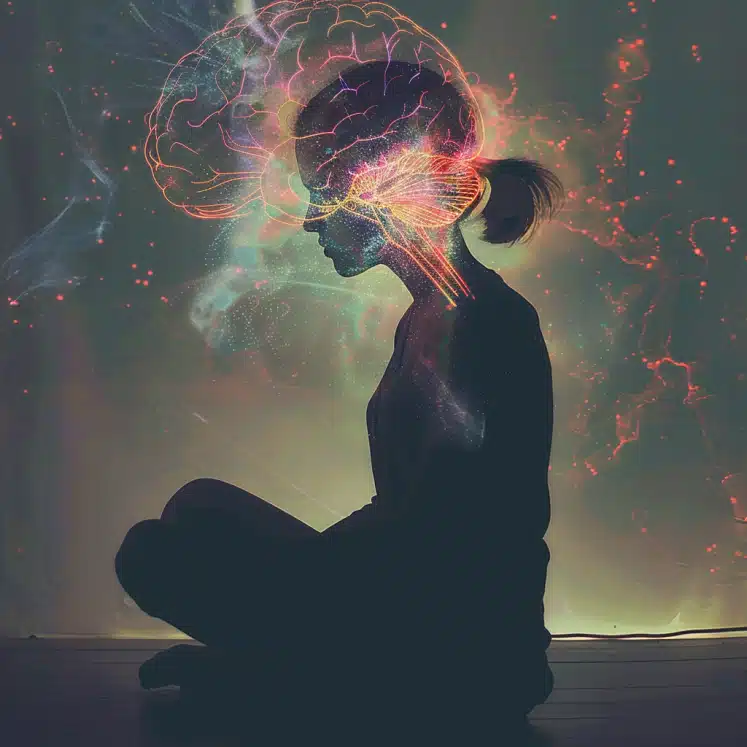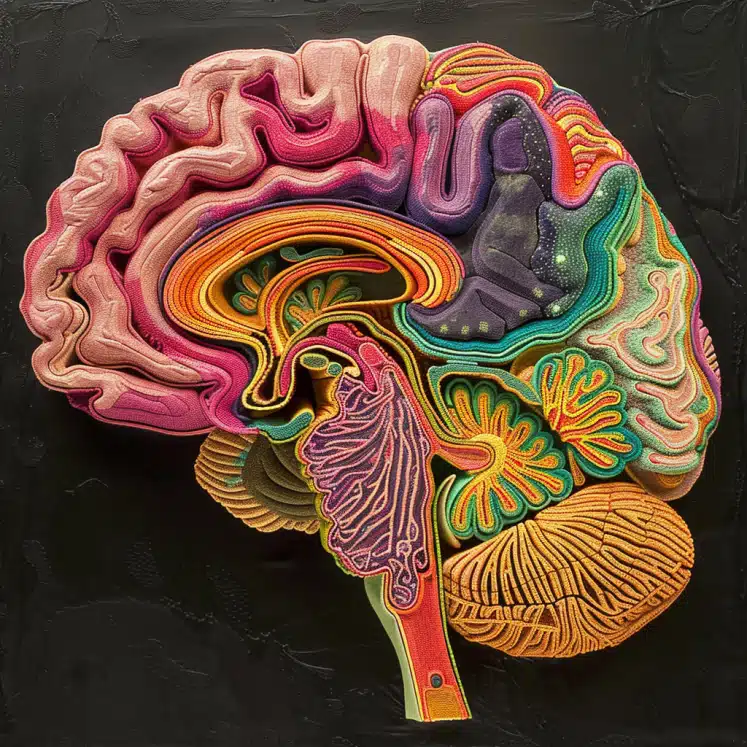Major depressive disorder (MDD) involves a topographic reorganization of brain activity from sensory to associative regions, affecting symptom co-occurrence through changes in neural dynamics and excitation-inhibition balance.
Highlights:
- Topographic Reorganization: MDD patients show a shift in brain activity from unimodal sensory regions to transmodal associative regions.
- Neural Dynamics: This shift includes changes in the brain’s dynamic timescales, moving from shorter to longer durations.
- Excitation-Inhibition Imbalance: Altered balance between excitation and inhibition in neural circuits contributes to the observed topographic changes.
- Symptom Co-occurrence: These neural alterations explain the simultaneous presence of diverse symptoms like affective, cognitive, and sensorimotor issues in MDD.
- Integrated Model: The study proposes a global approach linking these neural changes to the wide range of symptoms in MDD, termed “Topographic Dynamic Reorganization.”
Source: Translational Psychiatry (2024)
Depression & Brain Activity Reorganization (2024)
Included below are some key points made in a paper by Georg Northoff & Dusan Hirjak discussing brain reorganization in major depressive disorder (MDD).
1. Topographic Reorganization in Depression
Shift from Unimodal to Transmodal Regions
The study reveals that in MDD, brain activity undergoes a significant reorganization.
Typically, sensory and motor regions (unimodal) exhibit high activity.
However, in MDD patients, there’s a marked shift towards higher-order associative regions (transmodal), such as the default-mode network (DMN).
This shift disrupts normal brain function, linking diverse symptoms like emotional disturbances and cognitive impairments.
2. Neural Dynamics in Depression
Changes in Timescales
One of the critical findings is the alteration in the brain’s dynamic properties.
Normally, different brain regions operate on various timescales—shorter for sensory regions and longer for associative regions.
In MDD, there’s a shift towards longer timescales, especially in transmodal regions.
This means that brain activity in these regions is more prolonged and less responsive to rapid changes, contributing to symptoms like rumination and persistent negative thoughts.
4. Excitation-Inhibition Balance (Neural Activity)
Another crucial aspect is the imbalance between excitation (neurons firing) and inhibition (neurons being restrained) in the brain.
In MDD, there’s increased excitation relative to inhibition in transmodal regions, disrupting normal brain function.
This imbalance can lead to hyperactivity in certain brain circuits, exacerbating symptoms like anxiety and agitation.
5. Co-occurrence of Symptoms
Interconnected Symptoms
The study highlights how these neural changes lead to the simultaneous occurrence of diverse symptoms in major depressive disorder (MDD).
For example, increased synchronization between sensory and transmodal regions can result in both impaired perception (e.g., visual disturbances) and heightened emotional distress (e.g., sadness and anxiety).
This interconnectedness means that treating one symptom may impact others, underlining the complexity of MDD.
Neural Mechanisms of Depression Pathophysiology (2024)

Researchers proposed a global and dynamic topographic approach rather than focusing on specific brain regions or networks.
They aim to understand how shifts from unimodal (sensory and motor) to transmodal (associative) brain regions contribute to MDD’s complex symptomatology.
The paper links these topographic changes to two main mechanisms: dynamic shifts from shorter to longer timescales and abnormalities in the excitation-inhibition balance.
Sample
The study utilized data from multiple research sources, incorporating findings from recent fMRI studies and large-scale analyses. The sample size varied across different studies reviewed, including:
- Han et al. (2021): 71 acute MDD subjects and 71 healthy controls.
- Niu et al. (2021): Large-scale analyses without specific sample size mentioned.
- Javaheripour et al. (2022): 314 MDD patients and 498 healthy controls.
The focus was on both medicated and unmedicated MDD subjects to examine the neural underpinnings of the disorder.
Methods
Global Brain Activity Changes: The researchers reviewed recent findings on changes in global brain activity during rest and task states in MDD. This included examining the shift from unimodal to transmodal regions.
Dynamic Shifts: The study singled out two candidate mechanisms to explain the topographic changes:
- Dynamic Shifts in Timescales: Using techniques like fMRI and MEG, the researchers analyzed changes in the intrinsic neural timescales, particularly the autocorrelation window (ACW).
- Excitation-Inhibition Balance (EIB): Postmortem studies and neuroimaging data were used to examine changes in the EIB, focusing on levels of GABA and glutamate in different brain regions.
Functional Connectivity & Topography: Advanced imaging techniques such as functional connectivity measures and graph theoretic analyses were employed to understand the global signal topography and its alterations in MDD.
Task-Related & Resting-State Analyses: Studies were reviewed that investigated both resting-state and task-related global signal correlations (GSCORR) in MDD subjects, comparing them to healthy controls.
Limitations
- Heterogeneity of Samples: The studies reviewed included subjects with varying degrees of MDD severity and different treatment statuses (medicated vs. unmedicated), which might introduce variability in the findings.
- Cross-Sectional Nature: Much of the data reviewed comes from cross-sectional studies, limiting the ability to draw causal inferences about the observed topographic and dynamic changes.
- Measurement Limitations: Techniques like fMRI and MEG, while powerful, have inherent limitations in spatial and temporal resolution. The reliance on postmortem studies for EIB analysis also limits the ability to directly observe these changes in living subjects.
- Generalizability: The findings may not be fully generalizable to all MDD patients, especially considering the broad spectrum of symptoms and their varying severity across individuals.
- Complexity of Mechanisms: The proposed mechanisms (dynamic shifts and EIB changes) are complex and multifaceted. Further research is needed to fully elucidate these processes and their direct impact on MDD symptoms.
Competing Modern Theories of Major Depression Brain Activation

Resting State Hypothesis of Depression
This theory posits that MDD is characterized by abnormalities in the brain’s resting state networks, particularly the default-mode network (DMN).
According to this hypothesis, altered resting state activity leads to persistent negative thought patterns and rumination.
Comparison: While the resting state hypothesis focuses on specific networks and their activity during rest, the study proposes a more global approach, highlighting shifts from unimodal to transmodal regions and changes in dynamic brain activity. The proposed model extends the resting state hypothesis by incorporating dynamic shifts and excitation-inhibition imbalances, offering a more comprehensive understanding of MDD.
Predictive Coding Model
The predictive coding model suggests that mood states in MDD are the result of maladaptive higher-order predictions that reduce uncertainty about sensory and interoceptive states.
In MDD, the brain’s predictions become overly negative, leading to symptoms like persistent sadness and anhedonia.
Comparison: The proposed topographic dynamic reorganization model can integrate aspects of the predictive coding model. Both theories recognize the importance of higher-order brain functions in MDD, but the proposed model adds a layer of understanding by detailing how global shifts in brain activity and timescales contribute to these maladaptive predictions.
Monoaminergic Models
These models focus on the role of neurotransmitters like serotonin, norepinephrine, and dopamine in MDD.
They suggest that imbalances in these chemicals lead to mood disturbances and other symptoms associated with depression.
Comparison: The proposed model complements the monoaminergic models by explaining how neurotransmitter imbalances might lead to broader changes in brain topography and dynamics. For instance, altered serotonin levels could influence the excitation-inhibition balance, contributing to the observed topographic shifts from unimodal to transmodal regions.
Neuroinflammatory & Neuroendocrine Models
These models suggest that MDD is partly due to neuroinflammation and dysregulation of the hypothalamic-pituitary-adrenal (HPA) axis, leading to increased stress hormone levels and inflammatory markers that affect brain function.
Comparison: The topographic dynamic reorganization model can incorporate the neuroinflammatory and neuroendocrine models by considering how these physiological changes impact brain activity. For example, chronic inflammation might contribute to the altered excitation-inhibition balance and dynamic shifts observed in MDD.
Allostatic Load Model
This model views MDD as a result of cumulative physiological wear and tear due to chronic stress, leading to dysregulation across multiple body systems, including the brain.
Comparison: The proposed model aligns with the allostatic load model by highlighting the impact of chronic stress on brain function. It expands on this by detailing specific changes in brain topography and dynamics, providing a more granular understanding of how stress affects brain regions involved in MDD.
Conclusion: Major Depression & Brain Reorganization
References
- Study: Is depression a global brain disorder with topographic dynamic reorganization?
- Authors: Georg Northoff & Dusan Hirjak







